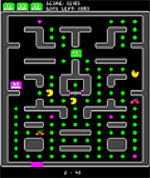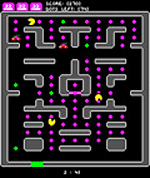January 8th, 2007
I returned from holidays on the East Coast to find this postcard in my mailbox. It’s the guys from Meetro (a startup here in San Francisco) done up like Bill Gates and the first Microsoft team back in the 70s.
Bravo, Paul & co. Details here.
Tags: funny: ha-ha, funny: strange, location-aware tech, san francisco | 4 Comments »
April 29th, 2006
Jane Jacobs died this week. She permanently changed the way I think and see.
Her book “The Death and Life of Great American Cities” overwhelmed me with feelings of serendipity and intimacy. It dug deep into a long series of my questions and observations about cities and neighborhoods and public spaces.
I kept bumping against these issues in the dark, struggling with common-sense suspicions that so much of the logic behind recent North American urban planning and housing development is just plain wrong and destructive — until Jacobs flipped on the spotlights and revealed the very real sources of those feelings.
She led me to an ongoing fascination with urban studies and architecture. I realized through Jacobs how important it is to understand the workings of places and flows of people in the city when designing new communications tech.
She underlined the need to break out of academic and professional echo chambers. To simply get out there and watch how things work, from the ground up. To plant the right seeds and get out of the way, rather than attempting to overdesign, to dictate, to predict the unpredictable.
She did all this through plain, passionate, human language, without an ounce of pedantry or arrogance.
Thanks Jane.
Tags: ideas, location-aware tech, miscellaneous | 1 Comment »
March 7th, 2006
I’m presenting PlaceSite this afternoon at the O’Reilly Emerging Technology Conference in San Diego. If you’re attending, please come say hi! Also: we’re teaming up with a few other scrappy startups to rent out a bar and host a party Wednesday night starting at 9 pm at the Caskroom, 550 Park Blvd., San Diego. If you’re in town, drop in and say hi!
In other news — today at ETech we’re announcing two new partnerships, with Sputnik and WaveStorm. Both are wi-fi infrastructure companies who help retail establishments and other venues to set up, maintain and manage public wi-fi networks. Sputnik’s an American firm based in San Francisco; WaveStorm is based in Paris and serves customers in Europe, Asia and the Middle East. PlaceSite’s community wi-fi software will be offered to customers of these firms.
Tags: location-aware tech, miscellaneous, wi-fi | Comments Off on PlaceSite at ETech / New Partnerships
June 24th, 2005
 Damon, Jon and I will present Project PlaceSite and discuss wi-fi cafe fun in San Francisco next week at Where 2.0, O’Reilly’s new conference about location-aware tech.
Damon, Jon and I will present Project PlaceSite and discuss wi-fi cafe fun in San Francisco next week at Where 2.0, O’Reilly’s new conference about location-aware tech.
If you’re there, come say hi.
Tags: location-aware tech, san francisco, wi-fi | Comments Off on Where 2.0
June 12th, 2005
A bizarre media storm has gathered around wireless Internet cafes. Project PlaceSite and I have benefited. But this all deserves a closer look.
Tomorrow’s New York Times quotes me in an article by Glenn Fleishman. My words appeared in a Seattle Post-Intelligencer piece last week. On May 30 a Financial Times article about wi-fi in cafes mentioned “zombie effect” [definition here], a term we invented to explain some of the reasoning behind PlaceSite. All this mainstream coverage followed Web buzz about an entry by Glenn on his Wi-Fi Networking News weblog. The entry announced that a Seattle cafe had tried turning off wi-fi on the weekends.
I’m thankful for the PlaceSite publicity but for the record: each of my partners, Damon McCormick and Jon Snydal, contributed to this project at least as much as I did. Professor Marti Hearst served a critical role as our project advisor.
A problem with the coverage: The Financial Times article strongly implies a trend in cafes across the country that involves reduction or removal of wi-fi access. But the opposite is true, at least in Seattle and San Francisco: wi-fi is becoming more ubiquitous in cafes. The article cites just three cafes — one in Seattle and two in San Francisco — that have limited their wi-fi access. But hundreds of cafes in these cities offer wi-fi service, and more cafes add wi-fi every month.
I see no evidence of a new trend: both of the San Francisco cafes in question have been experimenting with limited access for more than a year.
The other articles, particularly the New York Times piece, were more balanced and better informed about this. But I sense a media snowball effect that might trigger an avalanche of inaccurate coverage.
A warning to reporters: consider the numbers here, so you don’t mistake aberrant behavior for what’s clearly the norm.
Tags: ideas, location-aware tech, wi-fi | 9 Comments »
April 16th, 2005
[ UPDATE: Our launch period at A’Cuppa Tea is over. Keep an eye on placesite.com for news of upcoming launches. ]
 We’ll launch Project PlaceSite this Tuesday
We’ll launch Project PlaceSite this Tuesday
at A’Cuppa Tea cafe and teahouse in Berkeley.
Full details: PlaceSite.com.
Come out and join in!
Tags: berkeley, ideas, location-aware tech, wi-fi | 6 Comments »
March 13th, 2005
Imagine opening your laptop computer in a neighborhood wireless Internet caf� and firing up a Web browser. Instead of your usual startup page, imagine this on your screen:
That’s the core of Project PlaceSite. It introduces a new way of using wireless networks — to create a local information service by, for and about people who are in the same caf� together.
We’re rolling it out in Berkeley in a few weeks. Details: www.placesite.com.
Please let us know what you think. And come out and take part!
Tags: berkeley, ideas, location-aware tech, wi-fi | 4 Comments »
February 7th, 2005
Lars Holmquist spoke of “PacMan Must Die” at Intel’s Berkeley research lablet Friday.
This is an innovative game developed by Holmquist’s students at the Viktoria Institute’s Future Applications Lab in G–teborg, Sweden. It’s a tweaked-out multi-player version of the classic game Pac Man, with two major twists.
The first twist: characters’ roles are switched. Players control ghosts invading Pac Man’s home turf, trying to recover the dots stolen by Pac Man in the original game.
The second twist: the playing field is distributed across two or more devices held by multiple players.
To finish a level, a player must eat dots not just on her own screen, but on the other players’ screens as well. If you send your ghost through a doorway on the bottom of your screen, the ghost disappears from your device. It enters another player’s screen through a corresponding doorway. The game allows up to five players to join in on the distributed fun.
Players have to look over at one another’s screens to see where to guide their characters. Physical strategy and cooperation become central to this virtual game. Opportunities for new sorts of pranks arise — for instance, you can physically run off with your friend’s ghost.
I love this; it’s another way of combining video game fun with the fun of play in real-world places.
This is the sort of rich, simple innovation that I hoped would emerge with the wi-fi enabled Nintendo DS portable video game system. But Nintendo seems to have locked down DS development, limiting it to internal and professional developers. Such professionals have years of experience and training in building traditional games. This background cripples their ability to innovate, to see beyond the constraints of traditional game platforms.
Nintendo, learn from eBay and Google and Amazon: let customers and outsiders build value for you. Open your platform and let it thrive.
Tags: ideas, location-aware tech, wi-fi | 8 Comments »
October 20th, 2004
Why not use wi-fi (wireless Internet) access points to track down stolen cars, bikes, purses and other valuables?
Many of Earth’s major cities are becoming saturated with wi-fi access points. It’s hard to find a public place in San Francisco, for instance, where a wi-fi device can’t detect a nearby access point.
Imagine placing a narrow wi-fi beacon device inside the frame of your bicycle. You tell the beacon that, every day at 4 a.m., the bike is locked up at your house. Next time the clock strikes 4 a.m., the beacon turns itself on and it makes note of which wi-fi access points it can “see” from your home. It remembers that these access points represent home. Then it turns itself off again. (Wi-fi detection drains a lot of battery power — the device stays off most of the time to save juice).
Two days later, at precisely 4 a.m., the beacon powers on and notes what access points it can “see.” If it detects one or more of the “home” access points, it turns itself off again. Two days later it does the same thing, and so on. We’ll call this state of affairs the beacon’s default mode.
During one of these early-morning access-point checks, if the device doesn’t detect a home access point, it switches into “stolen mode.” It powers on every 15 minutes and checks for any open access points. (Open access points are not encrypted, so anyone — and in our case, any beacon — can use them to connect to the Internet.)
Read the rest of this entry »
Tags: ideas, location-aware tech, wi-fi | 25 Comments »
October 8th, 2004
 Look for unplanned potential within the Nintendo DS, an upcoming handheld videogame system. It uses wi-fi, as well as a proprietary Nintendo wireless format, to let a player compete and communicate with another in the same room, or with a potentially infinite number of other players via connections to the Internet through wi-fi hotspots. The New York Times says the unit will go on sale in the U.S. November 21 for $149.
Look for unplanned potential within the Nintendo DS, an upcoming handheld videogame system. It uses wi-fi, as well as a proprietary Nintendo wireless format, to let a player compete and communicate with another in the same room, or with a potentially infinite number of other players via connections to the Internet through wi-fi hotspots. The New York Times says the unit will go on sale in the U.S. November 21 for $149.
Nintendo’s marketing, the press, and the weblogs all seem fixated on the fact that this unit has two screens, and the fact that it will let people play the same old types of multiplayer games in mobile settings.
But I think a special combination of attributes make this a potential source of compelling new smartmobbish applications and behavior:
(1) Not only does it provide wireless networking capabilities, it’s built around using wi-fi in an ad-hoc person-to-person manner — regardless of whether wi-fi hotspots are nearby.
(2) When an open wi-fi hotspot is nearby, it can be used to connect from the field with servers on the Internet.
(3) Kids will use it, and kids aren’t locked into narrow wireless communication paradigms.
(4) It’s not too expensive, which might encourage a critical mass of these things in urban areas. (Compare it with Sony’s upcoming $300+ wi-fi-enabled PSP game device.)
Imagine the sociolocative fun that this might enable — if Nintendo doesn’t block out nonlicensed developers.
(Thanks to Matthew Rothenberg for the tip!)
Tags: ideas, location-aware tech, wi-fi | 4 Comments »



 We’ll launch Project PlaceSite this Tuesday
We’ll launch Project PlaceSite this Tuesday




 Look for unplanned potential within the
Look for unplanned potential within the